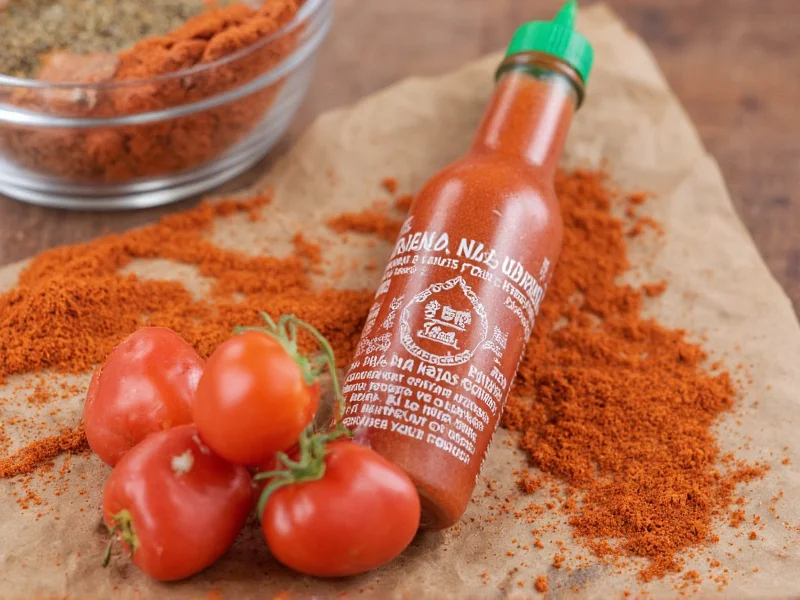Understanding Sriracha Seasoning: Beyond the Bottle
While most home cooks are familiar with the iconic rooster-branded sriracha sauce, the powdered seasoning version offers unique culinary advantages. The transformation from sauce to seasoning involves removing moisture while preserving the complex flavor profile that makes sriracha so popular. This dehydration process concentrates the flavors, creating a versatile spice that maintains the perfect balance of garlic heat, tangy vinegar notes, and subtle sweetness.
How Sriracha Seasoning Differs From Traditional Sauce
The fundamental difference between sriracha seasoning and its liquid counterpart lies in moisture content and application. Liquid sriracha works best as a condiment or mixed into wet ingredients, while the powdered version excels in dry applications where adding liquid would compromise texture. Understanding sriracha seasoning vs sauce helps home chefs select the right form for specific cooking techniques.
| Characteristic | Sriracha Sauce | Sriracha Seasoning |
|---|---|---|
| Form | Liquid | Dry powder |
| Moisture Content | High (approximately 90%) | Negligible |
| Best Applications | Dipping sauces, mixed into wet ingredients | Dry rubs, seasoning blends, finishing spice |
| Shelf Life (unopened) | 1-2 years | 2-3 years |
| Flavor Concentration | Standard | 3-4x more concentrated |
Composition and Flavor Profile
Authentic sriracha seasoning ingredients typically include ground red chili peppers, garlic powder, vinegar powder, sugar, and salt. Some premium versions add natural flavors or citric acid for brightness. The magic happens through careful balancing of these elements to recreate the signature profile:
- Heat level: Medium (1,000-2,500 Scoville units)
- Sweetness: Subtle sugar notes that balance the heat
- Garlic presence: Distinct but not overpowering
- Vinegar tang: Noticeable acidity that brightens dishes
Practical Applications in Cooking
Mastering how to use sriracha seasoning elevates everyday cooking. Unlike liquid sriracha, the powder won't make foods soggy, making it ideal for:
Dry Rubs and Marinades
Combine with paprika, cumin, and brown sugar for steak rubs, or mix with olive oil for chicken marinades. The powder adheres better than liquid sauce, creating a flavorful crust when seared.
Finishing Dishes
Sprinkle over finished dishes like popcorn, roasted vegetables, or grilled meats. The concentrated flavor means a little goes far—start with 1/8 teaspoon per serving and adjust to taste. This technique works particularly well for making recipes with sriracha seasoning where moisture control matters.
Baking and Dry Mixes
Incorporate into bread doughs, biscuit mixes, or savory pancakes. The powder distributes evenly without altering dough consistency, unlike liquid sriracha which would require recipe adjustments.
Storage and Shelf Life Considerations
Proper storage maintains flavor integrity. Keep sriracha seasoning in an airtight container away from heat and light. Unlike liquid sriracha which requires refrigeration after opening, the powder version remains stable at room temperature for 18-24 months. Humidity is the primary enemy—moisture causes clumping and flavor degradation. For extended storage, consider adding a silica packet to the container.
Creative Culinary Pairings
Discover the best dishes for sriracha seasoning by considering flavor affinities:
- Asian-inspired dishes: Toss with stir-fry vegetables before cooking
- Eggs and breakfast foods: Mix into scrambled eggs or avocado toast
- Seafood applications: Create a dry rub for salmon or shrimp
- Cocktail rims: Combine with salt for spicy margarita rims
- Homemade snacks: Toss with roasted chickpeas or nuts
Substitution Guidance
When substituting sriracha powder in recipes, remember:
- 1 teaspoon sriracha seasoning ≈ 1 tablespoon liquid sriracha (adjust liquids accordingly)
- For heat without garlic notes: cayenne + garlic powder
- For similar flavor profile: gochugaru + garlic powder + touch of sugar
- When moisture matters: use liquid sriracha and reduce other liquids
Understanding these substitutions proves invaluable when exploring sriracha seasoning ingredients alternatives for dietary restrictions or availability issues.
Common Questions About Sriracha Seasoning
Is sriracha seasoning the same as sriracha powder?
Yes, sriracha seasoning and sriracha powder refer to the same product—a dehydrated, powdered version of traditional sriracha sauce. The terms are used interchangeably in culinary contexts, though some manufacturers may use slight variations in their formulations.
Can I make my own sriracha seasoning at home?
Yes, you can create homemade sriracha seasoning by dehydrating liquid sriracha on low heat until completely dry, then grinding it into a fine powder. Alternatively, mix 2 tablespoons chili powder, 1 teaspoon garlic powder, 1 teaspoon sugar, 1/2 teaspoon salt, and 1/4 teaspoon citric acid to approximate the flavor profile.
Does sriracha seasoning contain MSG?
Most commercial sriracha seasonings do not contain MSG. Check ingredient labels carefully, as formulations vary by brand. Pure sriracha seasoning typically contains only dehydrated sriracha ingredients: chili peppers, garlic, vinegar, sugar, and salt.
How much sriracha seasoning equals one serving of liquid sriracha?
Generally, 1/4 to 1/2 teaspoon of sriracha seasoning equals one tablespoon of liquid sriracha. Start with smaller amounts and adjust to taste, as concentration varies between brands. Remember that the powder won't add moisture, so you may need to adjust other liquid ingredients in recipes.
What's the best way to incorporate sriracha seasoning into baked goods?
For baked goods, mix sriracha seasoning thoroughly with dry ingredients first. Start with 1/4 teaspoon per cup of flour and adjust to taste. It works particularly well in savory applications like cheese biscuits, cornbread, or pizza dough. Avoid high-heat baking above 400°F (204°C) to preserve the delicate flavor compounds.











 浙公网安备
33010002000092号
浙公网安备
33010002000092号 浙B2-20120091-4
浙B2-20120091-4